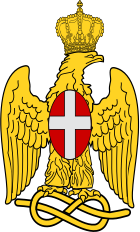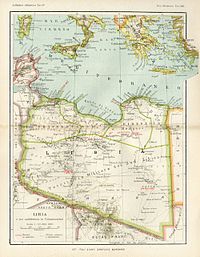
Italian East Africa was an Italian colony in the Horn of Africa. It was formed in 1936 after the Second Italo-Ethiopian War through the merger of Italian Somalia, Italian Eritrea, and the newly occupied Ethiopian Empire.
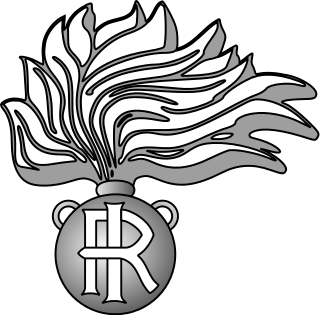
The Carabinieri are the national gendarmerie of Italy who primarily carry out domestic and foreign policing duties. It is one of Italy's main law enforcement agencies, alongside the Polizia di Stato and the Guardia di Finanza. As with the Guardia di Finanza but in contrast to the Polizia di Stato, the Carabinieri are a military force. As the fourth branch of the Italian Armed Forces, they come under the authority of the Ministry of Defence; for activities related to inland public order and security, they functionally depend on the Ministry of the Interior. In practice, there is a significant overlap between the jurisdiction of the Polizia di Stato and Carabinieri, although both of them are contactable through 112, the European Union's Single Emergency number. Unlike the Polizia di Stato, the Carabinieri have responsibility for policing the military, and a number of members regularly participate in military missions abroad.

The Italian Social Republic, known prior to December 1943 as the National Republican State of Italy, but more popularly known as the Republic of Salò, was a Nazi-German puppet state with limited diplomatic recognition that was created during the later part of World War II, which existed from the beginning of the German occupation of Italy in September 1943 until the surrender of German troops in Italy in May 1945. The German occupation triggered widespread national resistance against it and the Italian Social Republic, leading to the Italian Civil War.

Law enforcement in Italy is centralized on a national level, carried out by multiple national forces, helped by few limited local agencies. The Italian law enforcement system is considered complex, with multiple police forces and other agencies taking part in different duties. Policing in the Italian system refers to the duties of "full-powered officers" coming from the four national main forces: Polizia di Stato, Carabinieri, Polizia Penitenziaria and Guardia di Finanza. While the duties of these four corps' include investigating arresting, other local forces carry out limited duties.

Zaptié was the designation given to locally raised gendarmerie units in the Italian colonies of Tripolitania, Cyrenaica, Eritrea and Somaliland between 1889 and 1943.

The Royal Italian Army, reformed in 1861 and existed until 1946, participated in World War II. The Royal Army started with the unification of Italy (Risorgimento) and the formation of the Kingdom of Italy. It ended with the dissolution of the monarchy. The Royal Army was preceded by the individual armies of the independent Italian states and was followed by the Italian Army of the Italian Republic.

Libya was a colony of Fascist Italy located in North Africa, in what is now modern Libya, between 1934 and 1943. It was formed from the unification of the colonies of Italian Cyrenaica and Italian Tripolitania, which had been Italian possessions since 1911.

Castel Benito was an airport of Tripoli created by the Italians in Italian Libya. Originally, it was a small military airport, but it was enlarged in the late 1930s and was later used by the British RAF after 1943. It was called RAF Castel Benito by the Allies.

Castel Benito was an airport of Tripoli created by the Italians in Italian Libya in the early 1930s. It was called RAF Castel Benito by the Allies after 1943.
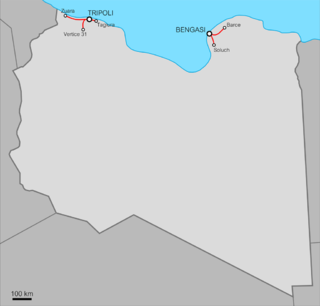
Italian Libya Railways was a group of railways built in the Italian colony of Libya between the two World Wars.
This is a list of words, terms, concepts, and slogans in the Italian language and Latin language which were specifically used in Fascist Italian monarchy and Italian Social Republic.

Italian Ethiopia, also known as the Italian Empire of Ethiopia, was the territory of the Ethiopian Empire which was occupied by Italy for approximately five years. Italian Ethiopia was not an administrative entity, but the formal name of the former territory of the Ethiopian Empire which now constituted the Governorates of Amhara, Harar, Galla-Sidamo, and Scioa after the establishment of Italian East Africa.

The Royal Corps of Colonial Troops was a corps of the Royal Italian Army, in which all the Italian colonial troops were grouped until the end of World War II in North Africa campaign.
The Republican Police Corps was a police force of the Italian Social Republic during the Italian Civil War.
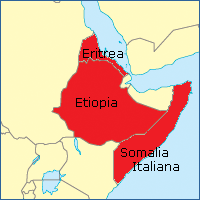
Operations on the Northern front, East Africa, 1940 in the Second World War, were conducted by the British in Sudan and the Armed Forces Command of Italian East Africa in Eritrea and Ethiopia. On 1 June 1940, Amedeo, Duke of Aosta the Viceroy and Governor-General of the Africa Orientale Italiana, commander in chief of the Armed Forces Command of the Royal Italian Army and General of the Air Force, had about 290,476 local and metropolitan troops and by 1 August, mobilisation had increased the number to 371,053 troops. General Archibald Wavell, General Officer Commanding-in-Chief (GOC-in-C) of Middle East Command, had about 86,000 troops at his disposal for Libya, Iraq, Syria, Iran and East Africa. About 36,000 troops were in Egypt and 27,500 men were training in Palestine.
Riccardo Astuto di Lucchese was an Italian diplomat and writer. He was born in Naples. He was the Italian colonial governor of Eritrea for five years, from 1930 to 1935.

The Italian colonial railways started with the opening in 1888 of a short section of line in Italian Eritrea, and ended in 1943 with the loss of Italian Libya after the Allied offensive in North Africa and the destruction of the railways around Italian Tripoli. The colonial railways of the Kingdom of Italy reached 1,561 kilometres (970 mi) before WWII.

The uniforms of the Italian Armed Forces include the official dress worn by members of the Italian Armed Forces while on duty. Each of the branches of the Italian Armed Forces, the Italian Army, the Italian Navy, the Italian Air Force, and the Carabinieri Corps, maintains its own style of dress. The Italian Armed Forces have an extensive history, during which they have undergone changes in the equipment they use, and the military uniforms they wear.

Riccardo Marraffa was an Italian soldier and civil servant, founder of the Italian Africa Police, which he commanded from 1936 to 1943.
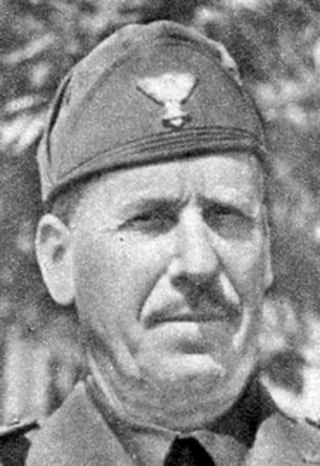
Archimede Mischi was an Italian Blackshirt general during World War II.
